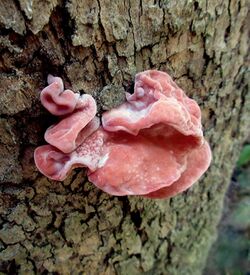Biology:Auricularia angiospermarum
| Auricularia angiospermarum | |
|---|---|

| |
| Auricularia angiospermarum on dead broadleaf tree, Missouri | |
| Scientific classification | |
| Domain: | Eukaryota |
| Kingdom: | Fungi |
| Division: | Basidiomycota |
| Class: | Agaricomycetes |
| Order: | Auriculariales |
| Family: | Auriculariaceae |
| Genus: | Auricularia |
| Species: | A. angiospermarum
|
| Binomial name | |
| Auricularia angiospermarum Y.C. Dai, F. Wu & D.W. Li (2015)
| |
Auricularia angiospermarum (wood ear or tree ear) is a species of fungus in the family Auriculariaceae. Basidiocarps (fruitbodies) are gelatinous, ear-like, and grow on dead wood of broadleaf trees. It is a North American species and was formerly confused with Auricularia auricula-judae which is confined to Europe.
Taxonomy
The species was originally described in 2015 from Connecticut on a fallen oak trunk. It had previously been referred to Auricularia americana 'deciduous unit',[1] but additional molecular research, based on cladistic analysis of DNA sequences, has shown that Auricularia angiospermarum is a distinct species.[2][3]
Description
Auricularia angiospermarum forms thin, brown, rubbery-gelatinous fruit bodies that are ear-shaped and up to 80 mm (3.1 in) across and 3 mm (0.12 in) thick. The fruitbodies occur singly or in clusters. The upper surface is finely pilose. The spore-bearing underside is smooth.[3]
Microscopic characters
The microscopic characters are typical of the genus Auricularia. The basidia are tubular, laterally septate, 45–65 × 3.5–5 µm. The spores are allantoid (sausage-shaped), 13–15 × 5–5.5 µm.[3]
Similar species
In North America, Auricularia americana is almost identical but grows on conifer wood.[2][3] On wood of broadleaf trees, Auricularia fuscosuccinea occurs in southern North America and typically has cinnamon-brown to purplish-brown fruitbodies.[1] Auricularia nigricans is also southern, but has a densely pilose upper surface.[1]
Habitat and distribution
Auricularia angiospermarum is a wood-rotting species, typically found on dead attached or fallen wood of broadleaf trees. It is widely distributed in North America, but is not currently known elsewhere.[3]
References
- ↑ 1.0 1.1 1.2 Looney, B. (2013). "Systematics of the genus Auricularia with an emphasis on species from the southeastern United States.". North American Fungi. doi:10.2509/naf2013.008.006. ISSN 1937-786X. http://dx.doi.org/10.2509/naf2013.008.006.
- ↑ 2.0 2.1 "Global diversity and taxonomy of the Auricularia auricula-judae complex (Auriculariales, Basidiomycota)". Mycological Progress 14 (10). 2015. doi:10.1007/s11557-015-1113-4.
- ↑ 3.0 3.1 3.2 3.3 3.4 "Global diversity and updated phylogeny of Auricularia (Auriculariales, Basidiomycota)". Journal of Fungi 7 (11): 933. 2021. doi:10.3390/jof7110933. PMID 34829220.
Wikidata ☰ Q111684981 entry
 |

